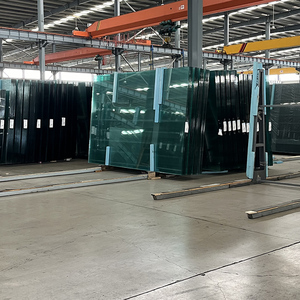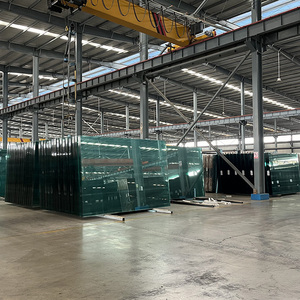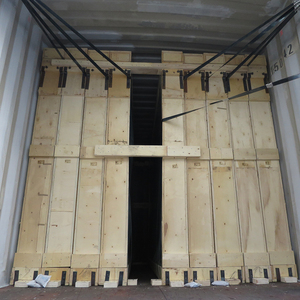
All categories
Featured selections
Trade Assurance
Buyer Central
Help Center
Get the app
Become a supplier

(1282 products available)



















































A tempered glass is a glass sheet that has been strengthened by heat treatment, making it safer and more durable than ordinary glass. Because of its many uses and applications, tempered glass has become a popular choice among designers and homeowners. However, its cost can vary significantly depending on various factors. Understanding these factors is essential for making informed decisions about purchasing and using tempered glass.
The first factor that affects the cost of tempered glass is the size. Like regular glass, tempered glass is available in various sizes. The size of the glass plays a crucial role in determining its cost. Larger sheets of tempered glass are more expensive than smaller ones, as they require more raw materials and have a longer production time. Additionally, the size of the glass can also affect its strength. In general, the larger the glass, the more fragile it is.
The thickness of tempered glass also affects its cost. As a rule of thumb, thicker tempered glass is more durable and stronger. As a result, it costs more than thinner glass. Thickness is an important consideration when purchasing tempered glass for any application, as it affects the glass's strength, safety, and cost.
The type of tempered glass also plays a major role when it comes to the cost. There are many types of tempered glass, and each glass variant has its own unique uses, applications, and benefits. As a result, the type of tempered glass determines its cost. For example, clear tempered glass is usually the cheapest, while low iron or frosted tempered glass tends to be more expensive.
Finally, the color of the tempered glass affects its price. Clear tempered glass is usually cheaper than colored tempered glass. This is because clear glass goes through fewer manufacturing processes than colored glass.
Other factors that affect the cost of tempered glass include the quality of the glass, the market demand, and the production techniques.
Understanding the tempered glass cost per square foot helps buyers see how price-sensitive the product can be. However, when looking at the features and functions, it becomes clear that the value added by tempered glass far outweighs any costs incurred.
Some of the features of tempered glass include:
Functions of tempered glass include:
Interior Design and Architecture:
Tempered glass is widely used in modern architecture and interior design, providing a sleek, contemporary aesthetic. Designers often use it in railings, partitions, and walls to create open, airy spaces without compromising safety or privacy.
Automotive Industry:
Tempered glass is used in car windows, including windshields, side windows, and rear windows. Its shatter-resistant properties ensure the safety of passengers in case of accidents.
Commercial Spaces:
Tempered glass is popular in office buildings, hotels, and restaurants. It is used for facades, conference room walls, and shower enclosures, providing a sophisticated look while allowing natural light to penetrate.
Residential Spaces:
Homeowners prefer tempered glass for patios, pool fences, and balustrades, ensuring safety without obstructing views. It is also used in doors and windows, providing a modern touch to any home.
High-Rise Buildings:
Tempered glass is used for curtain walls in skyscrapers, providing structural stability and safety to the building and its occupants. Its ability to withstand wind pressure and temperature changes makes it ideal for high-rise structures.
Sports Facilities:
Tempered glass is used in the walls of squash courts, ice hockey rinks, and indoor climbing walls. Its transparency allows spectators to see the action clearly, while its strength protects players and participants.
Aerospace:
Aircraft cockpit and passenger windows are made of tempered glass or polycarbonate. It is designed to withstand high pressures, extreme temperatures, and impacts during takeoff, flight, and landing.
Safety and Security Applications:
Tempered glass is used in bank counters, ATM enclosures, and jewelry store display cases. Its toughness and resistance to breaking make it a preferred choice for security applications.
Appliances:
Tempered glass is used in oven doors, microwave doors, and refrigerator shelves. Its ability to withstand high temperatures and frequent opening and closing cycles makes it ideal for kitchen appliances.
Consider the following when choosing tempered glass:
Safety and Strength
When choosing tempered glass for any project, it is important to consider safety and strength first. Look for high-quality tempered glass that has been properly produced and tested. This glass will be stronger and more durable. It will break into small, blunt pieces that are less likely to cause injury.
Clarity and Appearance
Check the clarity of the tempered glass. Go for glass with excellent optical clarity. This glass will have minimal distortion. Consider the appearance of the glass as well. Pick clear tempered glass if a transparent view is required. Frosted or tinted options are available for privacy or style.
Heat Resistance
Consider the heat resistance of the tempered glass. Pick glass types with high heat resistance if it's to be used in hot areas. Such areas include places with high temperatures or areas with direct sunlight.
Size and Thickness
The size and thickness of the tempered glass must be considered. Determine the maximum size that can be accommodated without losing structural integrity. Discuss with the supplier the available sizes and how to choose the best for the intended use.
Cost and Budget
The cost of tempered glass varies depending on the quality, size and thickness. Consider the budget available and balance cost with quality. Higher quality glass may cost more but it will offer better performance and longevity.
Supplier Reputation
Always choose a reputable tempered glass supplier. Check their certifications, reviews and industry experience. A good supplier will provide high-quality products and excellent customer service.
Q1: What is the price of tempered glass?
A1: The cost of tempered glass varies depending on the size, thickness, and any additional treatments. It is generally more expensive than regular glass due to its safety features and strength.
Q2: What is the size of a square foot of glass?
A2: A square foot is one square foot or 12 inches by 12 inches. To get the square footage of any glass, measure the area in square feet.
Q3: How can one calculate the square foot of glass?
A3: To calculate the square foot of glass, measure the length and width in feet, then multiply the two to get the square footage.
Q4: How long does tempered glass last?
A4: Tempered glass can last a lifetime. Unlike regular glass, it doesn't break into sharp pieces but rather into small granular pieces, which makes it safer.
Q5: Is tempered glass more durable?
A5: Yes, tempered glass is more durable. It is cut, heated, and cooled during the production process, which makes it strong and safe.